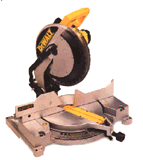
Miter Saw: $150 upwards
Compound Miter Saw: $200 upwards
Sliding Compound Miter Saw: $400 upwards
Miter saws replace the traditional miter box, the wooden box that allowed you to cut wood with a hand saw at angles of (typically) 45 and 90 degrees. The powered miter saw is, at its most basic, a large circular saw that pivots at its rear, allowing you to bring the saw blade down onto the wood. Any angle between 45 and 90 degrees can be cut. A compound miter saw allows the saw to additionally pivot to one side for cutting bevels.
While both types of saw are very effective, they have a limitation as to the length of the crosscut that is possible. This is typically limited to less than 10". To counter this problem, the latest breed of miter saws include a sliding function that allows the saw to pivot downwards and then slide towards you. This increases the cutting length of these tools significantly as well as having other benefits to boot. For example, the sliding mechanism allows you to cut down to a certain depth (rather than all the way though the wood) and then cut across at this depth. This is very useful for cutting grooves, or for cutting tennon joints.
However, it should be borne in mind that the miter saw is, in effect, a cut down version of a radial arm saw. If you have the money, you should consider investing in one of these, instead of a miter saw. The increased functionality -- especially the ability to rip wood -- is certainly worth considering. The alternative is to buy the compound miter saw and also purchase a table saw -- the best bet in our opinion.
When buying a miter saw consider the following:
Let the saw come up to speed before beginning to cut the wood. Slowly lower the spinning blade towards the wood and keep pushing through the wood at a smooth, slow constant rate. Once you have cut through the wood, let the blade come to a full stop before raising it again.
The smoothness of any cut depends on a number of factors. The type of material being cut, the type of blade (and how sharp it is) and the rate of cut all contribute to the quality of the final cut. The miter saw is typically purchased with a fairly coarse blade pre-installed (suitable for cutting joists and other rough work). If you are going to use the miter saw for more accurate work you should immediately invest in a finer toothed saw (60 teeth minimum). This finer blade, combined with a slow smooth cutting rate will produce the desired effect.

When cross cutting large planks, you will need to use additional supports to stop the wood from bowing. It is a good idea to make a small stand out of scrap wood so that you can support longer planks of wood (see diagram).
Although you will often just hold the wood in place with the pressure of your hands (but keeping your hands well clear of the blade), it is sometimes beneficial to clamp down the wood. This will stop the material from creeping sideways while cutting it.
If small splinters occur when cutting the wood, apply a strip of masking tape over the area that you will be cutting. Saw through the masking tape and then remove it. This should reduce the splintering.